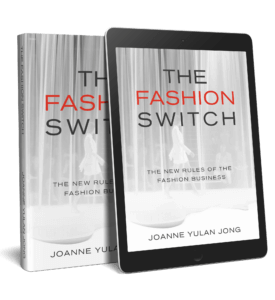The first eighteen months of setting up a fashion brand are the most crucial. If you make it past that post, making sure you’ve got the finance to stay in the game is what counts. Don’t take your collection to market until you are sure you can make money in fashion and afford to – writes Joanne Yulan Jong.
Sergio Galeotti, Giancarlo Giammetti, Domenico Del Sole, Patrizio Bertelli… These names may not instantly ring bells, but without them, the creativity of Armani, Valentino, Tom Ford and Prada may never have given rise to the commercial powerhouses that we know.
Without someone to look after the finances, designers get so caught up with the creative process that they ignore the need to plan their finances.
While you don’t have to go crazy with intricate details and financial breakdowns, a designer must have some understanding of costs and how to budget for the journey before it’s too late.
But when is too late?
It’s “too late” when you have pushed the button, taken your collection to market and fulfilled your first orders. At this point, a designer is fully entrenched in the fashion cycle of producing collections to show and sell, and it’s tricky to backtrack once you’re in the game.
While journalists may be (slightly) more forgiving, buyers demand consistency. Consistency means being professional, constantly staying one step ahead and deliver collections beautifully, above and beyond expectations. That’s a lot to expect and a lot to deliver. And it costs.
So when and how do I go about thinking about the finance? Won’t it stop me from launching my brand?
As a creative, it’s so easy to get lost in the wonderful process of creation and shove the boring financial stuff to one side. And when money is coming in, it’s even easier to postpone tackling that dull business plan.
Let me tell you my story…
After trading with my own label for four seasons, I realised that I could no longer ignore financial planning. The press coverage was so positive: I had features in Vogue and a double page in the International Herald Tribune during Milan Fashion Week. I was stocked with Matches and Net-a-Porter and had appointments with big international department stores. I believed the big orders and money would arrive somehow; my talent would be enough to make it. But, while all of this attention and praise was great, it’s the numbers behind the designer that enables a brand to survive and thrive.
I brought in a consultant to do my business plan and 3-year forecast. She did the maths and gave me the bad news: the figures were never going to stack up. My collection was high end, expensive to develop and produce, and directly in competition with established brands that were better-financed. It just did not make sense to carry on.
I burst into tears. I was massively disappointed but also relieved. Deep down I knew that the business wouldn’t work, but I needed to hear it from someone else. Having my own collection was so creatively satisfying, but far more work than I could have imagined. I’d been determined to carry on, thrilled by the press and buyers’ responses and the amazing support of family and my peers.
I returned to designing for other brands and the rest is history. I don’t regret my experience and don’t discount creating another label, but I wish that I’d listened to advice at the time.
The reality is within your own structure you are paying for the privilege in real monetary terms for the sampling, the production team, your physical time and your creative energy. It’s like you have pay for the materials to build your own car, plan the journey, they also pay for the driver, maintenance and the petrol.
While we can discuss how late it too late to make a plan, we can agree that it’s never too early. Even if your plan does not work out, you tried and were aware. Don’t take your collection to market until you are sure you can afford to.
If you have your own brand, you need to ring-fence the creative time within financial parameters that you understand and try (even roughly) to stick to.
Big companies have a budget for creative work and allow other departments deal with the rest of the process. That’s why it is so much more of a carefree environment for a designer to work within established companies with a structure. To return to my car analogy, working as a designer for an established company is like taking a ride in someone else’s lovely chauffeur-driven car. They are paying for everything including the petrol. All you need to do is read the map.
It’s rare for a designer to be able to wear all the various hats you need to run a fashion business effectively. Work out where your skillset starts and finishes and network quickly to find talented people to fill in the gaps. Once you cost out that support, take some time to make an informed decision about the viability of your business.
Mitch Hahn and Panayiota Koshias, both partners at Nordens Chartered Accountants, have several fashion businesses as clients so I asked them about the most common issues they encounter.
Here’s what they said:
1. CASHFLOW
“It is quite worrying how many businesses we come across that do not produce forecasts and more importantly cash flow forecasts. Cashflow is vital to any business, as without cash being available to run the day-to-day business, the business does not work. What this means is that a business may get a customer who may put in a big order but without the cash for manufacture/production costs, the sale would be lost. Lack of cashflow forecasts would also damage the chance of raising finance in these circumstances. A cashflow forecast allows businesses to pick up these issues before they happen, allowing for growth and flexibility”
2. MARGIN
“Some businesses generally believe that they know their gross profit margin, when in fact most of the time, due to a lack of understanding, their figures do not add up. In some cases, businesses are even making gross losses, which means that they are selling their products/garments for less than what it costs to produce. We work closely with clients to ensure they understand their business and to make sure that these things do not happen. The result of this should be that they have a profitable business and can achieve their personal goals”
I then asked what are their top three finance/accounting tips for a successful fashion business?
Number 1: Invest in a business plan forecasts and cash flow forecasts. Targets will be set based on business owner’s personal goals of where they would want to be in 1, 2, 3, or 5 years and with regular management accounts, they will be able to match targets with actual figures to see what needs to be done in order to achieve the end goal. You would not get in a car without knowing your final destination otherwise you will never get there, and it is the same with business. This will also allow issues to be addressed before they become a problem to the business.
Number 2: Spend the time understanding your business model and setting appropriate gross profit margins to cover your costs and overheads. This will ensure that you are at least making gross profits and not having to keep re-financing the company using your own personal money. This is key to running a successful and sustainable business in the fashion industry.
Number 3: Invest in a GOOD accountant. A good accountant will not just do your basic compliance year end accounts and tax, they will make sure you are set up in the most efficient way will cover all of the above for you and explain it in simple terms. They will allow YOU to do what you’re good at and run your business whilst providing all the support in the background covering all the work mentioned in previous points.
Like life, fashion never follows a straight path and things never quite turn out as planned. If you don’t have a Sergio Galeotti or a Giancarlo Giammetti, be wise enough to bring in help early to get the financials under control.
Are you a retailer or brand looking for help to move your business online? We can help you with your digital strategy, help you navigate the chaos and get you credible and visible and grow online. Contact us today.

Joanne Yulan Jong a Creative Director, Fashion Writer, and Author of the bestselling book THE FASHION SWITCH ‘The new rules if the fashion business’. She has been invited to be a regular columnist for WWD magazine.

